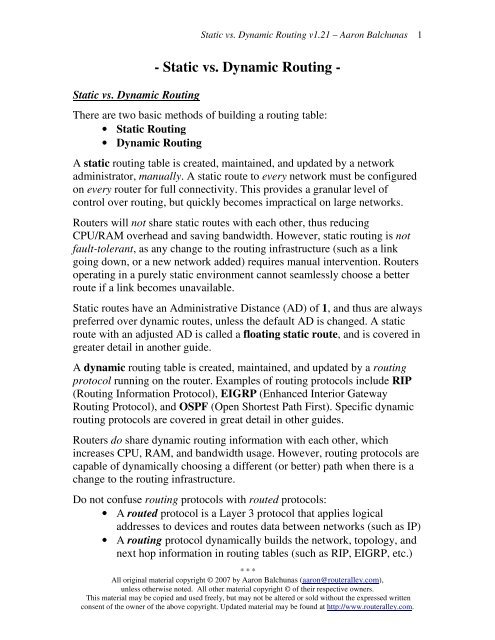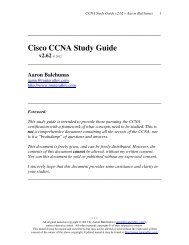Static vs. Dynamic Routing - Router Alley
Static vs. Dynamic Routing - Router Alley
Static vs. Dynamic Routing - Router Alley
Create successful ePaper yourself
Turn your PDF publications into a flip-book with our unique Google optimized e-Paper software.
<strong>Static</strong> <strong>vs</strong>. <strong>Dynamic</strong> <strong>Routing</strong> v1.21 – Aaron Balchunas<br />
1<br />
<strong>Static</strong> <strong>vs</strong>. <strong>Dynamic</strong> <strong>Routing</strong><br />
- <strong>Static</strong> <strong>vs</strong>. <strong>Dynamic</strong> <strong>Routing</strong> -<br />
There are two basic methods of building a routing table:<br />
• <strong>Static</strong> <strong>Routing</strong><br />
• <strong>Dynamic</strong> <strong>Routing</strong><br />
A static routing table is created, maintained, and updated by a network<br />
administrator, manually. A static route to every network must be configured<br />
on every router for full connectivity. This provides a granular level of<br />
control over routing, but quickly becomes impractical on large networks.<br />
<strong>Router</strong>s will not share static routes with each other, thus reducing<br />
CPU/RAM overhead and saving bandwidth. However, static routing is not<br />
fault-tolerant, as any change to the routing infrastructure (such as a link<br />
going down, or a new network added) requires manual intervention. <strong>Router</strong>s<br />
operating in a purely static environment cannot seamlessly choose a better<br />
route if a link becomes unavailable.<br />
<strong>Static</strong> routes have an Administrative Distance (AD) of 1, and thus are always<br />
preferred over dynamic routes, unless the default AD is changed. A static<br />
route with an adjusted AD is called a floating static route, and is covered in<br />
greater detail in another guide.<br />
A dynamic routing table is created, maintained, and updated by a routing<br />
protocol running on the router. Examples of routing protocols include RIP<br />
(<strong>Routing</strong> Information Protocol), EIGRP (Enhanced Interior Gateway<br />
<strong>Routing</strong> Protocol), and OSPF (Open Shortest Path First). Specific dynamic<br />
routing protocols are covered in great detail in other guides.<br />
<strong>Router</strong>s do share dynamic routing information with each other, which<br />
increases CPU, RAM, and bandwidth usage. However, routing protocols are<br />
capable of dynamically choosing a different (or better) path when there is a<br />
change to the routing infrastructure.<br />
Do not confuse routing protocols with routed protocols:<br />
• A routed protocol is a Layer 3 protocol that applies logical<br />
addresses to devices and routes data between networks (such as IP)<br />
• A routing protocol dynamically builds the network, topology, and<br />
next hop information in routing tables (such as RIP, EIGRP, etc.)<br />
* * *<br />
All original material copyright © 2007 by Aaron Balchunas (aaron@routeralley.com),<br />
unless otherwise noted. All other material copyright © of their respective owners.<br />
This material may be copied and used freely, but may not be altered or sold without the expressed written<br />
consent of the owner of the above copyright. Updated material may be found at http://www.routeralley.com.
<strong>Static</strong> <strong>vs</strong>. <strong>Dynamic</strong> <strong>Routing</strong> v1.21 – Aaron Balchunas<br />
2<br />
<strong>Static</strong> <strong>vs</strong>. <strong>Dynamic</strong> <strong>Routing</strong> (continued)<br />
The following briefly outlines the advantages and disadvantages of static<br />
routing:<br />
Advantages of<br />
<strong>Static</strong> <strong>Routing</strong><br />
Disadvantages of<br />
<strong>Static</strong> <strong>Routing</strong><br />
• Minimal CPU/Memory overhead<br />
• No bandwidth overhead (updates are not shared<br />
between routers)<br />
• Granular control on how traffic is routed<br />
• Infrastructure changes must be manually adjusted<br />
• No “dynamic” fault tolerance if a link goes down<br />
• Impractical on large network<br />
The following briefly outlines the advantages and disadvantages of dynamic<br />
routing:<br />
Advantages of<br />
<strong>Dynamic</strong> <strong>Routing</strong><br />
Disadvantages of<br />
<strong>Dynamic</strong> <strong>Routing</strong><br />
• Simpler to configure on larger networks<br />
• Will dynamically choose a different (or better)<br />
route if a link goes down<br />
• Ability to load balance between multiple links<br />
• Updates are shared between routers, thus<br />
consuming bandwidth<br />
• <strong>Routing</strong> protocols put additional load on router<br />
CPU/RAM<br />
• The choice of the “best route” is in the hands of<br />
the routing protocol, and not the network<br />
administrator<br />
* * *<br />
All original material copyright © 2007 by Aaron Balchunas (aaron@routeralley.com),<br />
unless otherwise noted. All other material copyright © of their respective owners.<br />
This material may be copied and used freely, but may not be altered or sold without the expressed written<br />
consent of the owner of the above copyright. Updated material may be found at http://www.routeralley.com.
<strong>Static</strong> <strong>vs</strong>. <strong>Dynamic</strong> <strong>Routing</strong> v1.21 – Aaron Balchunas<br />
3<br />
<strong>Dynamic</strong> <strong>Routing</strong> Categories<br />
There are two distinct categories of dynamic routing protocols:<br />
• Distance-vector protocols<br />
• Link-state protocols<br />
Examples of distance-vector protocols include RIP and IGRP. Examples of<br />
link-state protocols include OSPF and IS-IS.<br />
EIGRP exhibits both distance-vector and link-state characteristics, and is<br />
considered a hybrid protocol.<br />
Distance-vector <strong>Routing</strong> Protocols<br />
All distance-vector routing protocols share several key characteristics:<br />
• Periodic updates of the full routing table are sent to routing<br />
neighbors.<br />
• Distance-vector protocols suffer from slow convergence, and are<br />
highly susceptible to loops.<br />
• Some form of distance is used to calculate a route’s metric.<br />
• The Bellman-Ford algorithm is used to determine the shortest path.<br />
A distance-vector routing protocol begins by advertising directly-connected<br />
networks to its neighbors. These updates are sent regularly (RIP – every 30<br />
seconds; IGRP – every 90 seconds).<br />
Neighbors will add the routes from these updates to their own routing tables.<br />
Each neighbor trusts this information completely, and will forward their full<br />
routing table (connected and learned routes) to every other neighbor. Thus,<br />
routers fully (and blindly) rely on neighbors for route information, a concept<br />
known as routing by rumor.<br />
There are several disadvantages to this behavior. Because routing<br />
information is propagated from neighbor to neighbor via periodic updates,<br />
distance-vector protocols suffer from slow convergence. This, in addition to<br />
blind faith of neighbor updates, results in distance-vector protocols being<br />
highly susceptible to routing loops.<br />
Distance-vector protocols utilize some form of distance to calculate a<br />
route’s metric. RIP uses hopcount as its distance metric, and IGRP uses a<br />
composite of bandwidth and delay.<br />
* * *<br />
All original material copyright © 2007 by Aaron Balchunas (aaron@routeralley.com),<br />
unless otherwise noted. All other material copyright © of their respective owners.<br />
This material may be copied and used freely, but may not be altered or sold without the expressed written<br />
consent of the owner of the above copyright. Updated material may be found at http://www.routeralley.com.
<strong>Static</strong> <strong>vs</strong>. <strong>Dynamic</strong> <strong>Routing</strong> v1.21 – Aaron Balchunas<br />
4<br />
Link-State <strong>Routing</strong> Protocols<br />
Link-state routing protocols were developed to alleviate the convergence<br />
and loop issues of distance-vector protocols. Link-state protocols maintain<br />
three separate tables:<br />
• Neighbor table – contains a list of all neighbors, and the interface<br />
each neighbor is connected off of. Neighbors are formed by sending<br />
Hello packets.<br />
• Topology table – otherwise known as the “link-state” table, contains<br />
a map of all links within an area, including each link’s status.<br />
• Shortest-Path table – contains the best routes to each particular<br />
destination (otherwise known as the “routing” table”)<br />
Link-state protocols do not “route by rumor.” Instead, routers send updates<br />
advertising the state of their links (a link is a directly-connected network).<br />
All routers know the state of all existing links within their area, and store<br />
this information in a topology table. All routers within an area have identical<br />
topology tables.<br />
The best route to each link (network) is stored in the routing (or shortestpath)<br />
table. If the state of a link changes, such as a router interface failing,<br />
an advertisement containing only this link-state change will be sent to all<br />
routers within that area. Each router will adjust its topology table<br />
accordingly, and will calculate a new best route if required.<br />
By maintaining a consistent topology table among all routers within an area,<br />
link-state protocols can converge very quickly and are immune to routing<br />
loops.<br />
Additionally, because updates are sent only during a link-state change, and<br />
contain only the change (and not the full table), link-state protocols are less<br />
bandwidth intensive than distance-vector protocols. However, the three<br />
link-state tables utilize more RAM and CPU on the router itself.<br />
Link-state protocols utilize some form of cost, usually based on bandwidth,<br />
to calculate a route’s metric. The Dijkstra formula is used to determine the<br />
shortest path.<br />
* * *<br />
All original material copyright © 2007 by Aaron Balchunas (aaron@routeralley.com),<br />
unless otherwise noted. All other material copyright © of their respective owners.<br />
This material may be copied and used freely, but may not be altered or sold without the expressed written<br />
consent of the owner of the above copyright. Updated material may be found at http://www.routeralley.com.

















